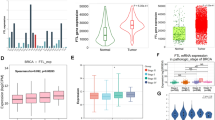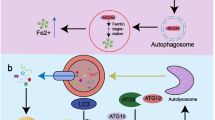Abstract
Breast cancer is the most common malignancy in women. Successful treatment of breast cancer relies on a better understanding of the molecular mechanisms involved in breast cancer initiation and progression. Recent studies have suggested a crucial role of perturbations in ferritin levels and tightly associated with this, the deregulation of intracellular iron homeostasis; however, the underlying molecular mechanisms for the cancer-linked ferritin alterations remain largely unknown and often with conflicting conclusions. Therefore, this study was undertaken to define the role of ferritin in breast cancer. We determined that human breast cancer cells with an epithelial phenotype, such as MCF-7, MDA-MB-361, T-47D, HCC70 and cells, expressed low levels of ferritin light chain, ferritin heavy chain, transferrin, transferring receptor, and iron-regulatory proteins 1 and 2. In contrast, expression of these proteins was substantially elevated in breast cancer cells with an aggressive mesenchymal phenotype, such as Hs-578T, BT-549, and especially MDA-MB-231 cells. The up-regulation of ferritin light chain and ferritin heavy chain in MDA-MB-231 cells was accompanied by alterations in the subcellular distribution of these proteins as characterized by an increased level of nuclear ferritin and a lower level of the cellular labile iron pool as compared to MCF-7 cells. We established that ferritin heavy chain is a target of miRNA miR-200b, suggesting that its up-regulation in MDA-MB-231 cells may be triggered by the low expression of miR-200b. Ectopic up-regulation of miR-200b by transfection of MDA-MB-231 cells with miR-200b substantially decreased the level of ferritin heavy chain. More importantly, miR-200b-induced down-regulation of ferritin was associated with an increased sensitivity of the MDA-MB-231 cells to the chemotherapeutic agent doxorubicin. These results suggest that perturbations in ferritin levels are associated with the progression of breast cancer toward a more advanced malignant phenotype.





Similar content being viewed by others
References
Jemal A, Siegel R, Ward E, Hao Y, Xu J, Thun MJ (2009) Cancer statistics, 2009. CA Cancer J Clin 59:225–249
Gonzalez-Angulo AM, Morales-Vasquez F, Hortobagyi GN (2007) Overview of resistance to systematic therapy in patients with breast cancer. Adv Exp Med Biol 608:1–22
Longley DB, Johnston PG (2005) Molecular mechanism of drug resistance. J Pathol 205:275–292
O’Driscoll L, Clynes M (2006) Biomarkers and multiple drug resistance in breast cancer. Curr Cancer Drug Targets 6:365–384
Coley HM (2008) Mechanism and strategies to overcome chemotherapy resistance in metastatic breast cancer. Cancer Treat Rev 34:378–390
Raguz S, Yagüe E (2008) Resistance to chemotherapy: new treatments and novel insights into an old problem. Br J Cancer 99:387–391
Lieghr JG, Jones JS (2001) Role of iron in estrogen-induced cancer. Curr Med Chem 8:839–849
Kabat GC, Rohan TE (2007) Does excess iron play a role in breast carcinogenesis? An unresolved hypothesis. Cancer Causes Control 18:1047–1053
Huang X (2008) Does iron have a role in breast cancer? Lancet Oncol 9:803–807
Arosio P, Ingrassia R, Cavadini P (2009) Ferritins: a family of molecules for iron storage, antioxidation and more. Biochim Biophys Acta 1790:589–599
Torti FM, Torti SV (2002) Regulation of ferritin genes and protein. Blood 99:3505–3516
Weinstein RE, Bond BH, Silberberg BK (1982) Tissues ferritin concentration in carcinoma of the breast. Cancer 50:2406–2409
Günner G, Kirkali G, Yenisey C, Töre IR (1992) Cytosol and serum ferritin in breast carcinoma. Cancer Lett 67:103–112
Higgy NA, Salicioni AM, Russo IH, Zhang PL, Russo J (1997) Differential expression of human ferritin H chain gene in immortal human breast epithelial MCF-10F cells. Mol Carcinog 20:332–339
Yang DC, Wang F, Elliot RL, Head JF (2001) Expression of transferring receptor and ferritin H-chain mRNA are associated with clinical and histopathological prognostic indicators in breast cancer. Anticancer Res 21:541–549
Mackay A, Jones C, Dexter T, Silva RLA, Bulmer K, Jones A, Simpson P, Harris RA, Jat PS, Neville AM, Reis LFL, Lakhani SR, O’Hare MJ (2003) cDNA microarray analysis of genes associated with ERB2 (HER2/neu) overexpression in human mammary luminal epithelial cells. Oncogene 22:2680–2688
Li YQ, Yan H, Bai B (2008) Change in iron transporter expression in human term placenta with different maternal iron status. Eur J Obstet Gynecol Reprod Biol 140:48–54
Schmittgen TD, Livak KJ (2008) Analyzing real-time PCR data by the comparative C(T) method. Nat Protoc 3:1101–1108
Zhang KH, Tian HY, Gao X, Lei WW, Hu Y, Wang DM, Pan XC, Yu ML, Xu GJ, Zhao FK, Song JG (2009) Ferritin heavy chain-mediated iron homeostasis and subsequent increased reactive oxygen species production are essential for epithelial-mesenchymal transition. Cancer Res 69:5340–5348
Kakhlon O, Cabantchik ZI (2002) The labile iron pool: characterization, measurement, and participation in cellular processes (1). Free Radic Biol Med 33:1037–1046
Tryndyak VP, Beland FA, Pogribny IP (2010) E-cadherin transcriptional down-regulation by epigenetic and microRNA-200 family alterations is related to mesenchymal and drug-resistant phenotypes in human breast cancer cells. Int J Cancer (in press)
Trudeau M, Charbonneau F, Gelmon K, Laing K, Latreille J, Mackey J, McLeod D, Pritchard K, Provencher L, Verma S (2005) Selection of adjuvant chemotherapy for treatment of node-positive breast cancer. Lancet Oncol 6:886–898
Kwok JC, Richardson DR (2002) The iron metabolism of neoplastic cells: alterations that facilitate proliferation? Crit Rev Oncol Hematol 42:65–78
Toyokuni S (2009) Role of iron in carcinogenesis: cancer as a ferrotoxic disease. Cancer Sci 100:9–16
Weinstein RE, Bond BH, Silberberg BK, Vaughn CB, Subbaiah P, Pieper DR (1989) Tissue ferritin concentration and prognosis in carcinoma of the breast. Breast Cancer Res Treat 14:349–353
Modjtahedi N, Frebourg T, Fossar N, Lavialle C, Cremisi C, Brison O (1992) Increased expression of cytokeratin and ferritin-H genes in tumorigenic of the SW 613-S human colon carcinoma cell line. Exp Cell Res 201:74–82
Wu CG, Groenink M, Bosma A, Reitsma PH, van Deventer SJH, Chamuleau RAFM (1997) Rat ferritin-H: cDNA cloning, differential expression and localization during hepatocarcinogenesis. Carcinogenesis 18:47–52
Wu KJ, Polack A, Dalla-Favera R (1999) Coordinated regulation of iron-controlling genes, H-ferritin and IRP2, by c-MYC. Science 283:676–679
Calzolari A, Oliviero I, Deaglio S, Mariani G, Biffoni M, Sposi NM, Malavasi F, Peschle C, Testa U (2007) Transferrin receptor 2 is frequently expressed in human cancer cell lines. Blood Cells Mol Dis 39:82–91
Richardson DR, Kalinowski DS, Lau S, Jansson PJ, Lovejoy DB (2009) Cancer cell iron metabolism and the development of potent iron chelators as anti-tumour agents. Biochim Biophys Acta 1790:702–717
Baldi A, Battista T, De Luca A, Santini D, Rossiello L, Baldi F, Natali PG, Lombardi D, Picardo M, Felsani A, Paggi MG (2003) Identification of genes down-regulated during melanoma progression: a cDNA array study. Exp Dermatol 12:213–218
Habashy HO, Powe DG, Staka CM, Rakha EA, Ball G, Green AR, Aleskandarany M, Paish EC, Douglas Macmillan R, Nicholson RI, Ellis IO, Gee JM (2010) Transferrin receptor (CD71) is a marker of poor prognosis in breast cancer and can predict response to tamoxifen. Breast Cancer Res Treat 119:283–293
Lin F, Girotti AW (1997) Elevated ferritin production, iron containment, and oxidant resistance in hemin-treated leukemia cells. Arch Biochem Biophys 346:131–141
Epsztejn S, Glickstein H, Picard V, Slotki IN, Breuer W, Beaumont C, Cabantchik ZI (1999) H-ferritin subunit overexpression in erythroid cells reduces the oxidative stress response and induces multidrug resistance properties. Blood 94:3593–3603
Berberat PO, Katori M, Kaczmarek E, Anselmo D, Lassman C, Ke B, Shen X, Busuttil RW, Yamashita K, Csizmadia E, Tyagi S, Otterbein LE, Brouard S, Tobiasch E, Bach FH, Kupiec-Weglinski JW, Soares MP (2003) Heavy chain ferritin acts as an antiapoptotic gene that protects livers from ischemia reperfusion injury. FASEB J 17:1724–1726
Cozzi A, Corsi B, Levi S, Santambrogio P, Albertini A, Arosio A (2000) Overexpression of wild type and mutated human ferritin H-chain in HeLa cells. J Biol Chem 275:25122–25129
Baldi A, Lombardi D, Russo P, Palescandolo A, De Luca A, Santini D, Baldi F, Rossielo L, Dell’Anna ML, Mastrofrancesco A, Maresca V, Flori E, Natali PG, Picardo M, Paggi MG (2005) Ferritin contributes to melanoma progression by modulating cell growth and sensitivity to oxidative stress. Clin Cancer Res 11:3175–3183
Kiessling MK, Klemke CD, Kaminski MM, Galani IE, Krammer PH, Gülow K (2009) Inhibition of constrictively activated nuclear factor-kappaB induces reactive oxygen species- and iron-dependent cell death in cutaneous T-cell lymphoma. Cancer Res 69:2365–2374
Burk U, Schubert J, Wellner U, Schmalhofer O, Vincan E, Spaderna S, Brabletz T (2008) A reciprocal repression between ZEB1 and members of the miR-200 family promotes EMT and invasion in cancer cells. EMBO Rep 9:582–589
Gregory PA, Bert AG, Paterson EL, Barry SC, Tsykin A, Farshid G, Vadas MA, Khew-Goodall Y, Goodall GJ (2008) The miR-200 family and miR-205 regulate epithelial to mesenchymal transition by targeting ZEB1 and SIP1. Nat Cell Biol 10:593–601
Hurteau GJ, Carlson IA, Roos E, Brock GJ (2009) Stable expression of miR-200c alone is sufficient to regulate TCF (ZEB1) and restore E-cadherin expression. Cell Cycle 8:2064–2069
Yang DC, Elliott RL, Head JF (2002) Gene targets of antisense therapies in breast cancer. Expert Opin Ther Targets 6:375–385
Author information
Authors and Affiliations
Corresponding author
Additional information
The views expressed in this paper do not necessarily represent those of the U.S. Food and Drug Administration.
Rights and permissions
About this article
Cite this article
Shpyleva, S.I., Tryndyak, V.P., Kovalchuk, O. et al. Role of ferritin alterations in human breast cancer cells. Breast Cancer Res Treat 126, 63–71 (2011). https://doi.org/10.1007/s10549-010-0849-4
Received:
Accepted:
Published:
Issue Date:
DOI: https://doi.org/10.1007/s10549-010-0849-4




